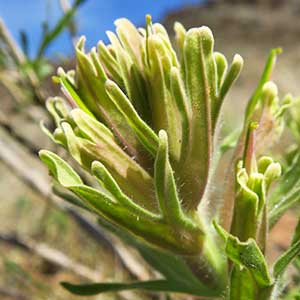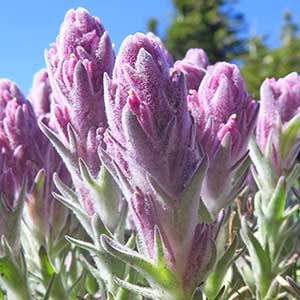Castilleja xanthotricha
Castilleja schizotricha
John Day or yellow-hairy paintbrush, John Day paintbrush, yellow hair paintbrush, yellow-hair Indian paintbrush
split hair Indian paintbrush, split-hair paintbrush
few to several, ± decumbent to erect or ascending, unbranched, sometimes with short, leafy axillary shoots, hairs erect to spreading, long, soft, eglandular, mixed with short stipitate-glandular ones.
few to many, ascending to erect, unbranched, hairs dense, appressed-ascending, matted, long, soft, branched, eglandular, ± white-woolly, obscuring surface.
green, linear, lanceolate to broadly lanceolate, oblong, or cuneate, 0.8–5 cm, not fleshy, margins plane to wavy, involute, 0–5-lobed, apex acute, sometimes rounded;
lobes spreading, linear, arising below mid length, nearly as broad as center lobe, apex acute.
gray-green with hairs, surface green to purple, linear-lanceolate, 0.5–2 cm, not fleshy, margins plane, ± involute, 0(–3)-lobed, apex acute to acuminate, sometimes rounded;
lobes sometimes divergent, spreading-ascending, narrowly linear, apex acute.
3–14 × 1.5–4.5 cm;
bracts proximally greenish, rarely dull reddish purple, distally white to cream, rarely pale yellow or dull, pale pink (sharply differentiated from proximal coloration), lanceolate or oblong to narrowly ovate, (3–)5–7-lobed;
lobes ascending, linear to obovate, ± broadened distally, medium, long, proximal lobes arising below mid length, central lobe apex broadly rounded to truncate, others acute to rounded.
3–8 × 1–2 cm;
bracts purple, lavender, pinkish, or dusty red throughout, sometimes greenish throughout or proximally greenish, distally colored as above, obscured by hairs, lanceolate, 3(–5)-lobed;
lobes ascending to erect, linear to oblanceolate, short, arising near or above mid length, apex obtuse.
curved, 17–23 mm;
tube 15–19 mm;
beak exserted, adaxially green, 5–8(–9) mm, puberulent, stipitate-glandular;
abaxial lip deep purple (color sometimes visible through calyx), green, pinkish, or pale yellow, ± prominent, slightly inflated, usually hidden in calyx, sometimes right at top of calyx, 2 mm, ca. 50% as long as beak;
teeth ascending, whitish, yellowish, pink, or green, 1–1.5 mm.
straight, 15–20 mm;
tube 8–9 mm;
beak included to slightly exserted, adaxially purple or pink, 3.9–5 mm, densely puberulent with white, woolly hairs;
abaxial lip deep purple, inconspicuous, pouched, pouches shallow, 3–5 mm, 80–100% as long as beak;
teeth upright-ascending, reduced, appearing white, 1.5–2 mm.
colored as bracts, 15–26 mm;
abaxial and adaxial clefts 3.5–7 mm, 25–50% of calyx length, deeper than laterals, lateral 2–5 mm, 12–25% of calyx length;
lobes linear, oblong, or narrowly triangular, center lobe apex usually rounded, lobes acute to rounded.
colored as bracts, 11–18 mm;
abaxial and adaxial clefts 3.5–6 mm, 33–50% of calyx length, all 4 clefts subequal, lateral 4–6 mm, 33–50% of calyx length;
lobes linear, apex acute.
= 48.
Castilleja xanthotricha
Castilleja schizotricha
Castilleja xanthotricha is endemic to moderate elevations in the sagebrush hills of the John Day River drainage in north-central Oregon. N. H. Holmgren (1971) hypothesized that this tetraploid species is of allopolyploid hybrid origin between C. glandulifera and C. oresbia.
(Discussion copyrighted by Flora of North America; reprinted with permission.)
Castilleja schizotricha is a rare species restricted to high elevations in the mountains in Siskiyou and Trinity counties in northwestern California and in Jackson and western Klamath counties in southwestern Oregon. See the discussion of 6. C. arachnoidea for morphological differences between it and C. schizotricha, as the two are sometimes confused. Though their ranges overlap, they do not appear to hybridize.
(Discussion copyrighted by Flora of North America; reprinted with permission.)



